The EastFruit team conducted a virtual study-tour for farmers in our region who are interested in growing greens and aromatic herbs as a greenhouse business. To do this, we visited the Italian company Orto Ricci, which produces aromatic herbs, salads and vegetables both on 30 hectares in Anzio, near Rome.
A video report on how aromatic herbs are grown in Italy, both packed and in pots, is available here. The information can be especially relevant for countries where culinary herbs are an important export item – – for Georgia and for Uzbekistan.
What notable things did we see in Orto Ricci? We saw how to make more than € 2 million per hectare growing aromatic herbs in a hydroponic system. We learned what sub-irrigation is, how sub-irrigation mats or auto-irrigation mats function, how a floating sub-irrigation system works, what are the advantages of the sea climate, how long a greenhouse can work, what is basil biofortification with selenium and why it is needed, how an integrated pest management helps in marketing and much more.
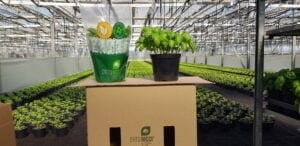
Assortment of aromatic herbs and vegetables
Orto Ricci has a huge assortment of aromatic herbs and even vegetables, but about 75% of their total revenue comes from one crop – basil. Why basil and where does so much of it go?
Italy is famous for its pizza and the most popular pizza is, of course, Margarita. And here you cannot do without the basil. However, it is also used in many other dishes – in famous pesto sauce, in baked goods and salads, as a seasoning for fish, etc. By the way, there are quite a few types of basil. In the assortment of “Orto Ricci”, in addition to ordinary basil, there are brown, red, lemon and licorice basil.
What’s interesting, even nettles are grown here As a part of the list of herbs offered by the company: common and marsh mint, lemon balm, marjoram, myrtle, rosemary, sage, catnip, savory, tarragon, thyme, coriander (cilantro), lavender, borage, oregano, chives, lemongrass! The assortment also includes leafy salads, pumpkin flowers, etc. A separate line is cherry tomatoes, peppers and other vegetables for indoor growing in pots, which many use as ornamental plants at home.
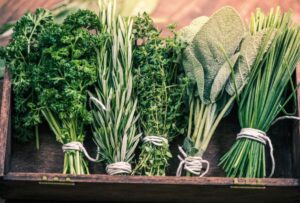
Dill and parsley
The most popular types of greens in the post-Soviet countries, such as dill and parsley are almost unknown here. Parsley is still used in some recipes, but dill is unknown in Italy. Fennel is sometimes found here, which is often confused with dill, but real dill is almost impossible to find. However, the country is home to several hundred thousand people from the post-Soviet space, mainly from Ukraine. Therefore, Orto Ricci is now setting up the production of both dill and parsley. After all, there is a demand, which means you can make money on it.
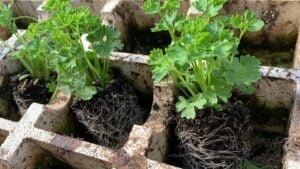
However, let’s move on to the actual greenhouse business of growing aromatic herbs.
Location, climate, exports and domestic market
Why do Italian producers try to be close to the sea? The climate is milder here – warmer in winter and cooler in summer. And this means saving money on heating greenhouses in winter and fewer diseases and pests.
Orto Ricci has tried exporting greens to the UK, but most packed herbs are not suitable for long-term storage and potted plants take up a lot of space and are too heavy to make exporting such products profitable. Therefore, they decided to sell their products not only in the domestic market of Italy but concentrated on the market of the capital region of Italy and other regions in central Italy. First, the market is large enough. Secondly, the logistics costs are lower. Thirdly, the quality and freshness of the products are thus perfect. Well, and fourthly, in this way the company avoids many other issues.
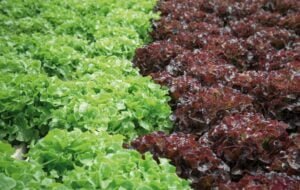
Types of greenhouses for growing aromatic herbs
The hydroponic greenhouses used for growing aromatic herbs are quite old – around 25 years old. These are glass greenhouses, with ventilation (opening vents on the roof) that is very important to keep the air humidity under control in summer. Indeed, in these greenhouses, greens are grown in special floating cassettes with sub-irrigation, which means the humidity is usually quite high that can lead to plant diseases.
There is full digitalization in greenhouses – climate, irrigation water composition and other growing parameters are monitored with a computer system. The greenhouse, accordingly, has a variety of sensors.
In winter, the main problem is a lack of light, which leads to a slowdown in plant growth and can provoke the spread of diseases. To reduce energy consumption for heating greenhouses, special heat-shielding curtains are opened over the plants at night, keeping heat.
In summer, on the contrary, glass and film greenhouses are whitened from the outside in order to avoid overheating of plants. The whitewash self-decomposes under the hot Roman sun over the summer and the transparency of the glass is restored by autumn without additional costs.
The company also uses foil greenhouses and even grows its produce outdoors in summer.
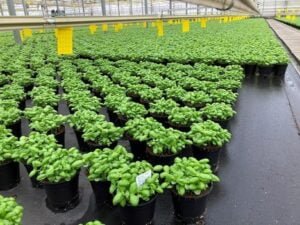
Types of irrigation, what is sub-irrigation and how the company saves water
Herbs are grown mainly either in a sterile environment on floating foam trays, or in pots on sub-irrigation mats (special rugs with auto-irrigation). In addition, some of the greens are grown in the ground.
In hydroponic greenhouses, plants simply float in the nutrient solution in special lightweight foam trays. Plants reach up to the solution with their roots and get the nutrients they need. At the same time, the leaves remain dry and clean, which helps avoid problems with diseases and pests, which means to ensure a higher purity of products and environmental friendliness of the business.
The nutrient solution is constantly aerated and the computer monitors its chemical composition to ensure the ideal nutrition for each crop.
To reduce water consumption, Orto Ricci has a rainwater collecting system that is purified and used in greenhouses. The irrigation water in which the trays with plants float is changed only once a year.
Subirrigation mats, also called self-irrigated rugs, are also used mainly in glass greenhouses, but for growing greens and vegetables in pots. The nutrient solution is supplied to the rug, and plants reach out to the roots through the hole in the pot to the rug and receive the nutrition they need. Thanks to this approach, both the substrate and the leaves of the plants remain dry, which makes production more environmentally friendly. In addition, this approach avoids unnecessary waste of water and fertilizers, because they are more efficiently used by plants.
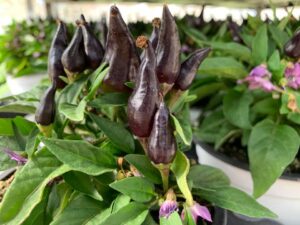
Integrated Plant Protection System (IPPS)
The company’s agronomists are constantly experimenting, trying to find approaches to reduce or completely eliminate the use of crop protection chemicals. Thanks to IPPS, an integrated approach is used that ensures the minimum use of chemical plant protection products when growing greens, salads and vegetables. For example, we were shown an experiment how the proximity of different crops in a greenhouse affects their development. This allows to discover new solutions for improving the sustainability and environmental friendliness of the business.
Labor force is an important factor in competitiveness
Since growing greenery, despite the maximum levels of business automation, requires a lot of manual labor, the cost of labor has a high share in the cost of the herbs. Most likely, this is another reason why the company relied on fresh herbs, because it avoids competition with imports from countries where labor is cheaper.
Orto Ricci employs many foreigners, mostly from Punjab, India. Therefore, all announcements and messages in the company’s greenhouses are duplicated in Italian and Punjabi. The employment is all official and the labor costs the company about 10 € per hour taxes included.
Cleaning of the herbs
Greenery is harvested by taking trays with plants and placing them in a special cutting machine. The roots remaining in the trays are shaken out, and undamaged trays are cleaned for reuse.
Cut greens are packed in bags for sale in supermarket chains. To increase the implementation period, only preliminary washing is carried out, and consumers should wash the greens once again.
Cleaning up potted greenery is not a problem at all. Since the pots are on sub-irrigation mats, you just need to pick them up and pack them.
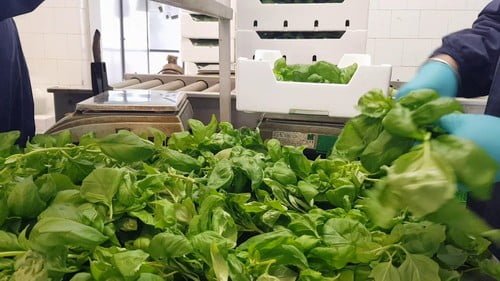
Plastic-free biodegradable packaging and pots
The company takes pride in its efforts to reduce its negative impact on the environment. All packaging used by the company is biodegradable.
One of the hot questions is the use of biodegradable pots for growing potted greens and vegetables. The fact is that supermarkets require such greens to be supplied in biodegradable pots. However, they cost three times more than ordinary ones, and consumers pay attention not to the pot, but to the herb and its price. Therefore, greens in ordinary plastic pots can win in price.
Productivity of herbs with year-round cultivation
The yield of basil in hydroponic greenhouses on sub-irrigation is from 7 to 10 tons per cycle from each hectare of greenhouses. The cycle lasts about 20 days in summer and about 30 days in winter. On average, it is possible to make about 14 production cycles per year. This means that the yield is about 120 tons per hectare.
Considering that the average selling price for cut basil, which is usually sold in packs of 50 grams, is 20 euros per kg, the total revenue per hectare of such greenhouses exceeds 2 million euros per year.
Herbs, Nickel-Free Basil and Selenium Biofortification of Basil
An interesting observation is that the company would like to grow smaller potted herbs than it currently does. This would lead to faster turnover. In addition, these greens are healthier for consumers. However, buyers prefer overgrown greens because think they are buying more.
A very important indicator of the quality of greens is their low nickel content – almost nickel-free.
The growing demand for a healthy lifestyle is constantly forcing the company to look for new ways to increase the benefits of the herbs. One of these areas was the cultivation of basil with a high selenium content.
Selenium is considered one of the most important trace minerals for human health. It plays an essential role in the functioning of the thyroid gland and in metabolism. Selenium helps protect cells from damage and oxidative stress by strengthening immunity, improving brain function, and even reducing the risk of heart disease.
Selenium is believed to help prevent some liver diseases, protect body from heavy metal poisoning. Since selenium is involved in the metabolism of iodine, this makes it an essential element for humans.
That is why Orto Ricci has been developing a program for biofortification or bio-saturation of the basil grown here with selenium for two years now.
Since selenium in basil accumulates better if plants get it through the roots, and not through foliar feeding, this was great for a company where sub-irrigation is mainly used.
As young leaves contain more selenium, the company was looking for the fastest growing varieties of basil. As a result, the choice was made in favor of the Gemini basil variety from SAIS Sementi. In addition, a cultivation technology has been worked out, which would make it possible to obtain the same yield of basil biofortified with selenium as for the ordinary basil. The company hopes this will give it an additional competitive advantage in Italy’s highly competitive market of fresh herbs.

Competition in the green market continues to increase
Since growing aromatic herbs allows for a high income per hectare of land, competition in this market continues to grow. The growth of competition in the market is taking place despite the high investment required to create modern greenhouses.
In addition, the world is now experiencing a real boom in investments in greenhouse technology and especially in the creation of vertical farms, which allows to grow greens anywhere and even in large cities.
However, these technologies have not yet found widespread use in Italy, and Orto Ricci, thanks to its continuous improvement of the quality, environmental friendliness and freshness of herbs, feels quite confident on the market, continuing to develop.
The EastFruit team is grateful to Orto Ricci for the opportunity to learn from them and for their openness in providing information.
The use of the site materials is free if there is a direct and open for search engines hyperlink to a specific publication of the East-Fruit.com website.




